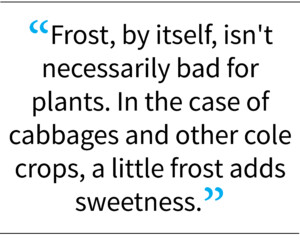Your Garden … with Kate Russell: With cold winter weather approaching, protect your Gilroy garden
Keep protections handy until Gilroy’s last frost date, which is March 20
Published in the November 25 – December 8, 2020 issue of Gilroy Life

Kate Russell
By Kate Russell

Photo courtesy National Geographic Society
Frost can damage plants in Gilroy from Nov. 21 through March 20, on average. This year’s first frost came early.
In nature, plants protect themselves from winter cold by absorbing lots of water from the ground and heat from the soil. Plants also go through chemical changes that help prevent death by freezing. Sometimes, those adaptations are not enough and damage can occur. And sometimes plants die.
The two most common winter garden problems are frost damage and sunscald. You can prevent sunscald by whitewashing exposed branches and trunks with a 50/50 mix of latex paint and water. Do not use enamel paint.
Frost, by itself, isn’t necessarily bad for plants. In the case of cabbages and other cole crops, a little frost adds sweetness. The problem is that frost occurs in the same conditions that lower a plant’s internal temperature to the point that cell walls break down. If you’ve ever left tender plants out in the cold, you have probably seen the mushy brown result.
 According to the most recent USDA Hardiness Zone Map, all of Gilroy is now in zone 9b. This means Nov. 21 is our first frost date. But frost dates are only statistical averages. Frost can come earlier than that (as it did this year) and it is better to be prepared. Rather than putting off frost protection until it’s too late, it is far easier (and more comfortable for you) to have everything ready before you need it. Start by collecting old sheets to use as plant coverings. Umbrellas and row cover materials also work well. Paper or plastic can be used, but they are not as effective.
According to the most recent USDA Hardiness Zone Map, all of Gilroy is now in zone 9b. This means Nov. 21 is our first frost date. But frost dates are only statistical averages. Frost can come earlier than that (as it did this year) and it is better to be prepared. Rather than putting off frost protection until it’s too late, it is far easier (and more comfortable for you) to have everything ready before you need it. Start by collecting old sheets to use as plant coverings. Umbrellas and row cover materials also work well. Paper or plastic can be used, but they are not as effective.
Cover plants in the late afternoon anytime frost is expected, and uncover them first thing in the morning. The fabric should not touch the plants directly. You can use plant stakes or long-handled tools to raise the fabric above the plant surface. Allow the material to drape, rather than gathering it around the base of the plant. This lets soil heat radiate up into the space.
 Be sure to water plants thoroughly. Well hydrated plants are less likely to freeze. And avoid fertilizing late in the growing season; wait until after leaf drop. Container plants can be brought closer to the house, or indoors for the winter season. Finally, avoid chemical sprays. They do not work nearly as well as advertised. In severe cases, you can turn on the sprinklers. Just be sure to leave the sprinklers on until temperatures rise above freezing.
Be sure to water plants thoroughly. Well hydrated plants are less likely to freeze. And avoid fertilizing late in the growing season; wait until after leaf drop. Container plants can be brought closer to the house, or indoors for the winter season. Finally, avoid chemical sprays. They do not work nearly as well as advertised. In severe cases, you can turn on the sprinklers. Just be sure to leave the sprinklers on until temperatures rise above freezing.
If frost damage occurs, you may be able to save your plants. They might not look nice again until spring, but leave frost and ice damaged leaves in place. They provide layers of insulating protection. The only exceptions are soft-stemmed plants. In those cases, damaged areas should be removed completely, to avoid rot spreading into healthy tissue.
Keep protections handy until Gilroy’s last frost date which is March 20.

